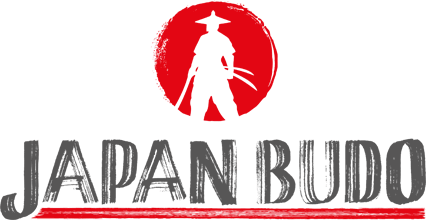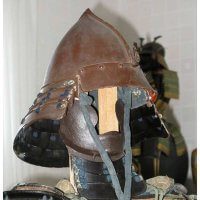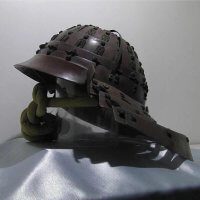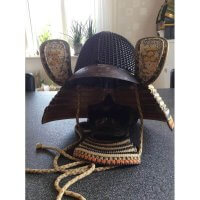Antique Kabuto
The infamous samurai helmet Kabuto
Here you will find an exclusive selection of helmets from different eras of Japanese history. Each one is a historical original.
Showing all 4 resultsSorted by popularity
Showing all 4 resultsSorted by popularity
Like the rest of the samurai armour, the helmet is made to the highest standard by specialist craftsmen.
However, the samurai helmet receives even more attention than the other pieces of armour.
This is due to its complex structure, but also to the fact that it was often additionally decorated.
The tradition and significance of the Japanese samurai helmet
![]() =Kabuto: A traditional Japanese samurai helmet, is a symbol of power, strength and honour.
=Kabuto: A traditional Japanese samurai helmet, is a symbol of power, strength and honour.
In the fascinating world of samurai and Japanese warriors, it embodies the refined craftsmanship, deep cultural significance and martial tradition of the ancient Japanese warrior class.
Let's delve into the history, construction, symbolism and significance of the legendary samurai helmet.
The story: From protection to symbol
The history of kabuto goes back hundreds of years, to the time of the samurai in medieval Japan.
Originally designed to protect the warrior's head during battle as a simple component of the complete Samurai armourOver the course of time, it developed into an artistic and symbolic masterpiece.
The use and design of the helmet were closely linked to the social hierarchy and the status of the warrior.
The construction: a masterpiece of craftsmanship
The kabuto consists of several components, including the helmet crown (hachi), the helmet peak (mae-zashi) and the neck guard (shikoro).
Each component has been carefully designed and manufactured to provide not only protection, but also elegance and strength.
The materials range from lacquered leather to laminated iron plates that are joined together to create a robust structure.
The symbolism: power, honour and tradition
The kabuto was not only a practical protective element, but also a symbol of power, honour and tradition.
The design and decorations on the helmet can represent the warrior's clan affiliation, his military successes or his family history.
Furthermore, additional ornaments such as crest hoops (maedate) were often added to emphasise the wearer's uniqueness and personality.
The importance today: preserving culture and heritage
Although the kabuto is no longer worn in battle today, it has retained its place as a symbol of Japanese culture and martial heritage.
In museums, collections and traditional events, the samurai helmet is valued as a work of art and historical artefact.
Through preservation and appreciation, people can continue to explore and understand the values and teachings of the samurai era.
The production and care of Kabuto: an art that must be preserved
Making an authentic Japanese helmet requires master craftsmanship and attention to detail. The helmet makers use traditional techniques and materials to make each one a unique masterpiece.
Regular care and maintenance is important to preserve the beauty and functionality.
This includes cleaning, oiling and occasional repairs to ensure that the helmet remains in optimum condition.
The importance for modern society: a source of inspiration
The Kabuto serves not only as an object of the past, but also as a source of inspiration for people in modern society.
Its profound symbolism and artistic design have inspired many artists, designers and filmmakers to create contemporary works that celebrate the beauty and power of the original.
By preserving and recognising them, we can keep the traditions and teachings of the samurai era alive.
Conclusion: Preserving heritage and beauty
Overall, the Kabuto is a fascinating symbol of Japanese culture, history and the art of war.
Its significance extends far beyond its physical function and reflects the values and traditions of times gone by.
By researching, preserving and appreciating the ancient samurai helmet, we can honour the heritage of the samurai and pass on the beauty of these artistically designed helmets.




